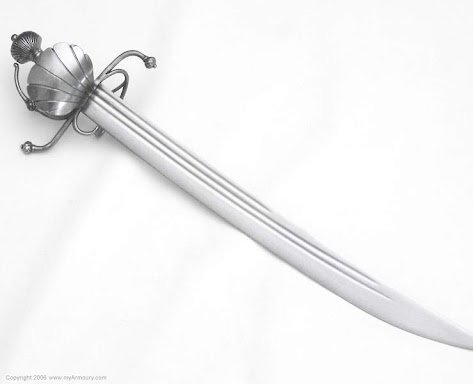
Dusack
The dusack (also spelled dussack or dusägge) is a single-edged training weapon used primarily in the German martial tradition of the 16th and 17th centuries. It is a short, curved weapon, often with a wide blade that tapers to a rounded or pointed tip. The dusack was commonly made from wood, leather, or metal, depending on its intended use, and served as both a practice weapon for single-edged swords, like sabres or messers, and as a tool for sportive combat.
The hilt of a dusack typically has a simple design, with a curved crossguard or a single knuckle bow to protect the wielder’s hand. The weapon’s lightweight and compact design made it ideal for quick, agile movements, focusing on cutting and thrusting techniques.
In Joachim Meyer’s 1570 fencing manual, the dusack is featured as part of a training curriculum, allowing students to practice guards, strikes, parries, and counter-techniques safely. It was a popular weapon for developing skills in blade control, timing, and distance, while also being used in friendly competitions and training scenarios.
The dusack represents a transitional weapon, blending the martial practicality of combat swords with the safety and accessibility needed for fencing practice, embodying the educational and sportive spirit of Renaissance martial arts.
Joachim Meyer’s dusack system, as presented in his 1570 treatise, is a comprehensive and dynamic approach to training with single-edged weapons. The dusack, a short, curved training sword, serves as a versatile tool for practicing techniques that can be applied to other single-handed weapons like the messer, sabre, or falchion. Meyer’s dusack system blends martial effectiveness with a sportive, instructional focus, making it both practical and accessible.
Key Elements of Meyer’s Dusack System:
- Guards (Huten): Meyer teaches various guards, which are positions used to prepare for attacks or defenses. These guards provide a solid foundation for engaging the opponent dynamically and adapting to different scenarios.
- Cuts and Thrusts: The system incorporates an array of cutting techniques (häue), including diagonal, vertical, and horizontal strikes, as well as thrusting attacks. These strikes emphasize fluidity and precision, designed to exploit openings in an opponent’s defense.
- Parries and Counters: Defensive techniques such as parries (versetzen) and counter-attacks form a crucial part of the system. Meyer trains fencers to displace their opponent’s blade and respond immediately with ripostes or follow-up strikes.
- Footwork and Timing: The dusack system places strong emphasis on footwork and timing (vor and nach), enabling fencers to maintain control of the fight. Movements are designed to manage distance effectively while positioning the fencer for both offense and defense.
- Drills and Set Plays: Meyer includes structured drills and set plays to teach specific techniques and strategies. These exercises help students internalize key principles and prepare for practical applications.
- Adaptability: A central feature of Meyer’s dusack system is its adaptability. The techniques learned with the dusack are meant to translate seamlessly to other single-edged weapons, making it an essential part of Meyer’s broader fencing curriculum.
Meyer’s dusack system is notable for its balance of martial realism and sport-like training, reflecting the Renaissance ideals of blending combat skill with physical education and artful expression. It remains an important element of historical European martial arts studies today.